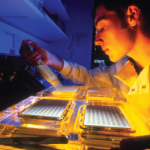RA and Lupus
More Clues to Genetic Roots of RA and SLE
Remmers EF, Plenge RM, Lee AT, et al. STAT4 and the risk of RA and systemic lupus erythematosus. N Engl J Med. 2007;357(10):977-986.
Abstract
Background: RA is a chronic inflammatory disease with a substantial genetic component. Susceptibility to disease has been linked with a region on chromosome 2q.
Methods: We tested single-nucleotide polymorphisms (SNPs) in and around 13 candidate genes within the previously linked chromosome 2q region for association with RA. We then performed fine mapping of the STAT1-STAT4 region in a total of 1,620 case patients with established RA and 2,635 controls, all from North America. Implicated SNPs were further tested in an independent case-control series of 1,529 patients with early RA and 881 controls, all from Sweden, and in a total of 1,039 case patients and 1,248 controls from three series of patients with systemic lupus erythematosus (SLE).
Results: A SNP haplotype in the third intron of STAT4 was associated with susceptibility to both RA and SLE. The minor alleles of the haplotype-defining SNPs were present in 27% of chromosomes of patients with established RA, as compared with 22% of those of controls (for the SNP rs7574865, p=2.81×10-7; odds ratio for having the risk allele in chromosomes of patients versus those of controls, 1.32). The association was replicated in Swedish patients with recent-onset RA (p=0.02) and matched controls. The haplotype marked by rs7574865 was strongly associated with lupus, being present on 31% of chromosomes of case patients and 22% of those of controls (p=1.87×10-9; odds ratio for having the risk allele in chromosomes of patients versus those of controls, 1.55). Homozygosity of the risk allele, as compared with absence of the allele, was associated with a more than doubled risk for lupus and a 60% increased risk for RA.
Conclusions: A haplotype of STAT4 is associated with increased risk for both RA and SLE, suggesting a shared pathway for these illnesses.
Plenge RM, Seielstad M, Padyukov L, et al. TRAF1-C5 as a risk locus for RA—a genome-wide study. N Engl J Med. 2007;357(12):1199-1209.
Abstract
Background: RA has a complex mode of inheritance. Although HLA-DRB1 and PTPN22 are well-established susceptibility loci, other genes that confer a modest level of risk have been identified recently. We carried out a genome-wide association analysis to identify additional genetic loci associated with an increased risk of RA.
Methods: We genotyped 317,503 SNPs in a combined case-control study of 1,522 case subjects with RA and 1,850 matched control subjects. The patients were seropositive for autoantibodies against cyclic citrullinated peptide (CCP). We obtained samples from two data sets, the North American RA Consortium (NARAC) and the Swedish Epidemiological Investigation of RA (EIRA). Results from NARAC and EIRA for 297,086 SNPs that passed quality-control filters were combined with the use of Cochran-Mantel-Haenszel stratified analysis. SNPs showing a significant association with disease (p<1×10-8) were genotyped in an independent set of case subjects with anti–CCP-positive RA (485 from NARAC and 512 from EIRA) and in control subjects (1,282 from NARAC and 495 from EIRA).
Results: We observed associations between disease and variants in the major-histocompatibility-complex locus, in PTPN22, and in a SNP (rs3761847) on chromosome 9 for all samples tested, the latter with an odds ratio of 1.32 (95% confidence interval, 1.23 to 1.42; p=4×10-14). The SNP is in linkage disequilibrium with two genes relevant to chronic inflammation: TRAF1 (encoding tumor necrosis factor (TNF) receptor-associated factor 1) and C5 (encoding complement component 5).
Conclusions: A common genetic variant at the TRAF1-C5 locus on chromosome 9 is associated with an increased risk of anti–CCP-positive RA.
Commentary
The genetic susceptibility of autoimmune disorders, including RA and SLE, has proven to be complex. In RA, the contribution of the human leukocyte antigen (HLA) locus, HLA-DRB1, has been well recognized and supported by family studies.1 Other previously reported susceptibility loci for RA include variants of the Protein Tyrosine Phosphatase N22 (PTPN22), Cytotoxic T-Lymphocyte Antigen 4 (CTLA-4), and peptidyl arginine deiminase, type IV (PADI4).2-4 As the scale of genome wide studies expands, finer resolution studies will likely uncover further loci with more modest effects. Recently, two articles have unveiled additional single nuclear polymorphisms (SNP) that are associated with susceptibility in RA.
Plenge et al. reported the results of a genome-wide association study using an anti–CCP-positive population of RA patients. Using a multistage study design with multiple sample sets, the authors confirmed the association around the HLA-DRB1 and PTPN22 loci. In addition, this study newly identified a 100-kb region on chromosome 9, containing TRAF1 (encoding tumor necrosis factor associated factor 1) and C5 (encoding complement component 5). Although both TRAF1 and C5 were interesting candidate genes, a single causal allele was not identified.
A separate linkage peak conferring susceptibility to RA had been previously identified in the long arm of chromosome 2 (2q) in genome-wide studies.5 Building on this finding, Remmers et al. undertook a large case-control disease-association analysis of 13 selected candidate genes within this chromosome 2q linkage region. They confirmed a SNP in CTLA4, with a known association, but also revealed an association with an unlinked SNP in STAT4 (encoding signal transducer and activator of transcription 4).
Further fine mapping of the STAT1-STAT4 region demonstrated an association with four SNPs in the third intron of the STAT4 gene. There was no difference between the anti–CCP-positive and -negative subgroups, and the effect was not attributable to the CTLA4 association in the same region. This region had also been reported to have an association with SLE.6,7 The authors went on to genotype three series of SLE case control subjects with European ancestry. They found a strong association with the STAT4 variant in all three series.
These studies underscore the potential importance of intracellular signaling in the pathogenesis of autoimmune disease. Traf1 mediates signal transduction through TNF receptors, and Stat 4 is a key transcription factor that transmits signals from pro-inflammatory cytokines including IL-12 and IL-23. Although there is compelling biologic data on the roles of these cytokines and complement in RA, these genetic studies are presented without any functional data. Future studies will therefore need biochemical evaluation of the influence of these variants on protein expression and function. These studies also provide intriguing hints to overlapping mechanisms in diseases like RA and SLE, which have both distinctive and mutual features. However, whether the propensity to generate specific autoantibodies (i.e. anti–CCP) is genetically determined remains to be fully elucidated. Eventually, the use of individual genetic profiles could lead to customized treatment to target defective or overactive pathways to maximize efficacy and minimize side effects.
References
- Wordsworth BP, Salmon M. The HLA class II component of susceptibility to RA. Baillieres Clin Rheumatol. 1992;6:325-336.
- Begovich AB, Carlton VE, Honigberg LA, et al. A missense single-nucleotide polymorphism in a gene encoding a protein tyrosine phosphatase (PTPN22) is associated with RA. Am J Hum Genet. 2004;75:330-337.
- Seidl C, Donner H, Fischer B, et al. CTLA4 codon 17 dimorphism in patients with RA. Tissue Antigens. 1998;51:62-66.
- Suzuki A, Yamada R, Chang X, et al. Functional haplotypes of PADI4, encoding citrullinating enzyme peptidylarginine deiminase 4, are associated with RA. Nat Genet. 2003;34:395-402.
- Amos CI, Chen WV, Lee A, et al. High-density SNP analysis of 642 Caucasian families with RA identifies two new linkage regions on 11p12 and 2q33. Genes Immun. 2006;7:277-286.
- Gray-McGuire C, Moser KL, Gaffney PM, et al. Genome scan of human systemic lupus erythematosus by regression modeling: evidence of linkage and epistasis at 4p16-15.2. Am J Hum Genet. 2000;67:1460-1469.
- Cantor RM, Yuan J, Napier S, et al. Systemic lupus erythematosus genome scan: support for linkage at 1q23, 2q33, 16q12-13, and 17q21-23 and novel evidence at 3p24, 10q23-24, 13q32, and 18q22-23. Arthritis Rheum. 2004;50:3203-3210.

